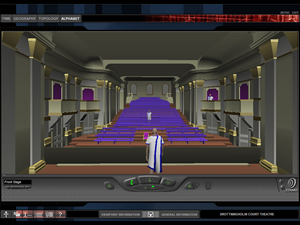History & Project overview
Theatron 3 consists of 25 historic European performance places, ranging from 5th century B.C.E. to the twentieth century, built in the Virtual World 'Second LifeTM', together with virtual guides and a host of interactive tools, scenarios and tutorials, customisable actors, props, sound effects, lighting and scenic technologies, streaming video and a 'Director' tool to enable users to create live performances.
The project is being undertaken by King's Visualisation lab within the Centre for Computing in the Humanities (CCH) at King's College London. Funding has been generously provided by Eduserv.
An educational component to the project is being managed by the Higher Education Academy Dance, Drama & Music (PALATINE), and English Subject Centres at five universities across the UK.

- The original Theatron environment in 'Full screen mode'.
Background
In 2002 a six-partner international consortium, led by Professor Richard Beacham, completed and launched the Theatron project, funded under the EU Telematics in Education, Training, and Research Programme . This online interactive educational module comprised digital 3D models of 19 milestones in European theatre design: the Bayreuther Festspielhaus, Drottningholm Palace Theatre, Drury Lane, Epidaurus, Globe Theatre, Greek Temporary Stages, Hellerau Festspielhaus, Medieval ecclesiastical drama settings, Medieval pageant stages, Odeon of Agrippa, Odeon of Pericles, Roman Temporary Stages, Schaubühne am Lehniner Platz (Berlin), Teatro Farnese, Teatro Olimpico, Teatro Sabbionetta, Théâtre du Vieux-Colombier, Theatre of Dionysus, and the Theatre of Pompey.
Each was meticulously researched by subject experts, modelled following rigorous standards of architectural and archaeological accuracy, and contextualised with a vast array of graphic and textual materials. Each site was represented by both a simple, real-time navigable model and a collection of pre-rendered images and animations of highly detailed models.
Users can study the critical analyses of the spaces provided, but can also independently assess the evidence on which the 3D reconstructions are based (letters, critical descriptions, architectural texts, sketches, drawings and paintings etc.). The application was unprecedented as an ICT learning tool for higher education, and widely acclaimed, winning a 21st-century achievement award as Laureate in the Computerworld Honors Program and was the subject of several case studies in the EU Digicult Technology Watch Reports.
Theatron3 is transforming this content, and additional content since created by KVL, into an extensive, content-rich range of research-based virtual environments in Second Life, generating highly innovative, interactive teaching and learning resources designed to take full advantage of the pedagogical potential of the environment.
Project objectives
The project has produced a set of complex virtual spaces, free at point of use for education and performance, capitalising on the existing assets of Theatron and newer assets. The development of a customised open source Second Life client (which is now possible) has allowed real-time navigation to be combined with high graphical quality. The 3D models are supplemented by existing and new interpretative content and a spectrum of original interactive tools, scenarios and automated tutorials, incorporating manipulable and customisable actors, props, sound effects and scenic technologies, streaming video and scripts enabling individual and group movement/choreography.
New educational activities have developed and implemented at partner instiutions across a wide range of Higher Education subject areas - including scenography, creative writing, theatre design in addition to the performing arts - to take advantage of the social, collaborative and interactive aspects of this shared virtual environment. Taking advantage of pre-existing assets worth an estimated €1.2m and the KVL team's expertise acquired through developing the Theatron Module and related projects, this programme of applied research into effective e-learning in shared virtual environments, together with its digital outcomes, has made a significant advance in the sophistication and scale of deployments of shared virtual environments in Higher Education, nationally and internationally as well as our understanding of the nature of learning and teaching in these environments.
Methodology
Over 24 months, King's Visualisation Lab has been responsible for overall project direction and management, content provision, quality assurance for architectural modelling and pedagogical resources, and has collaborated with other partners to design educational scenarios. With colleagues in King's Digital Consultancy Services , KVL has developed non-profit economic models to secure the long-term sustainability of the digital resources, while safeguarding the principle that access should be free at point of use.